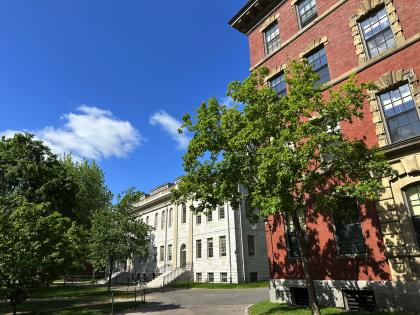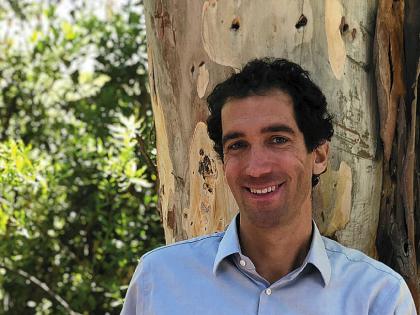Peter Ellison's On Fertile Ground is a truly extraordinary, state-of-the-art book on a topic that concerns all human beings as individuals and a host of others professionally. So many superlatives may seem inappropriate, but they are not. Ellison is a cutting-edge scientist: a leading researcher in the field of human reproductive physiology. He brings to bear an unparalleled perspective-- derived from both anthropology and biology--that makes a diverse and conflicting field of research suddenly comprehensible by demanding that human reproduction be viewed as the product of evolution, responsive to ecological conditions, with its own unique evolutionary history.
 |
| In the Ituri Forest of the Congo, Efe Pygmy women collect a saliva sample from an infant for medical analysis. |
| Photograph by Peter Ellison |
Because Ellison is an anthropologist, his research and theoretical questions are grounded in a world that includes not just modern Western societies but also the cross-cultural record. He talks to us about the fertility of modern women who postpone maternity until their late thirties; of male athletes who take anabolic steroids; of fertility and birth-spacing among women hunter-gatherers in Paraguay and the Congo; and of the trade-offs among fertility, childcare, and physical labor made by women tribal farmers in Mali and Gambia and peasant women in Poland and Bangladesh. The cross-cultural record proves to be a critical piece for understanding human reproductive biology because it shows the interplay between human reproductive physiology and disease, diet, and labor--an interplay that is nearly masked in the modern societies where women are healthy, well-fed, and rarely do heavy physical labor either as young girls, as mothers, or as matrons past menopause.
 |
| Lese mother and child. The decorative scarring is common among this Congo people. |
| Photograph by Peter Ellison |
Ellison's broad perspective is further enriched with a powerful framework from biology called life-history theory (reflected as well in his ordering of topics: from ovulation to implantation, birth, lactation, human growth and development, puberty, and finally the development of the sex differences in men and women). Life-history theory analyzes growth, development, sex differences in behavior and biology, immune competence and physical vigor, mate choice, reproduction, and parental investment from the perspective of allocations of time and energy during the life course. Since time and energy are by definition in limited supply, the challenge to the individual is how to determine such allocations so as to optimize reproductive success in a specific ecological environment.
Ellison uses life-history theory to inform us about differences between men and women in their adaptations for successful reproduction. For example, male biology allocates more time and energy to growth in the interests of larger body size and muscularity--which delays the maturation of males compared to females. Male physiology also produces the hormone testosterone, which stimulates male sex differences in behavior and morphology but is costly in terms of immune competence. Women must make physiological and behavior-al trade-offs among fertility (conceiving again), lactation (sustaining the current infant), and physical labor (feeding older, weaned children). Both parents must make decisions about the allocation of care to current versus future reproduction. Ellison's decision to present complex information within a framework of life-history theory not only makes the book comprehensible, but also will keep it central to the field long after details of specific data have been replaced by more and even better research.
Both lively and lucid, On Fertile Ground, unlike so many popular evolutionary-science books, rests on facts and data, not just anecdotes. Ellison explores the implications of scientific discoveries about fertility and implantation for the use of birth control and abortifacients such as the IUD or RU486 and for the successes and failures of modern fertility clinics. At another point he changes focus by presenting the history of scientific thought about population growth and the policy implications of human reproductive ecology. We are challenged to think about what changes in breastfeeding practices--such as bottle-feeding, enrichment of maternal diet, or reduction in lactation duration--might lead to in terms of population growth and child health. The complex interrelations of maternal health, work effort, infant growth, lactation duration, and maternal fertility, Ellison suggests, argue against simplistic interventions that may instead induce a wave of unsought results. His full presentation of what has recently been learned about the reproductive physiology and ecology of men is especially valuable because male fertility is so under-researched. Many books present men only as eager sperm donors and say little about the tradeoffs, mentioned earlier, that must be faced in male life histories: between growth and reproduction, health and testosterone, and investment in the offspring of present and future mates.
  |
| Left: An Efe father holds his newborn outside a leaf hut. The Efe are mobile hunters and gatherers who build new shelters whenever they shift camps within the rain forest. Right: An Efe child wearing a traditional bark-cloth garment. |
| Photographs by Peter Ellison |
On Fertile Ground is a must for the libraries of scholars interested in human reproduc-tive biology, clinicians working in human fertility and development, and the educated lay public who want to understand both their own behavior and biology and that of others. "Each birth," Ellison writes, "produces more than a human being; it produces new human relationships, new threads in a fabric of kinship and community. Reproduction is the crucible for the perpetuation of our cultures as well as our genes....Our communal fate hangs on our ability to balance our individual procreative desires and our social responsibilities."







